Buses in Sydney
 | |
%2C_operated_by_Sydney_Buses%2C_Bustech_VST_bodied_Scania_K280UB_on_Loftus_Street_in_Circular_Quay.jpg) Scania K280UB with Bustech VST body, in Transport NSW livery | |
| Overview | |
|---|---|
| Locale | Sydney |
| Transit type | Bus / Bus rapid transit |
| Annual ridership | 264.3 million in 2017-18 |
| Website | transportnsw.info |
| Operation | |
| Began operation | 1905 |
| Operator(s) | |
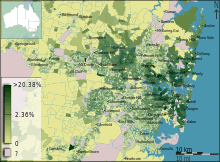
Buses account for close to six per cent of trips each day in the Australian city of Sydney, New South Wales, forming a key part of the city's public transport system. The network initially evolved from a privately operated system of feeder services to railway stations in the outer suburbs, and a publicly operated network of bus services introduced to replace trams in the inner suburbs. The bus network has undergone major reform in recent years, with the New South Wales Government taking responsibility for route and fare-setting, opening contracts for most routes up to competitive tendering, and introducing more cross-regional services.
The New South Wales Government's transport authority, Transport for NSW, administers the various bus networks in Sydney.
- Commuter bus services including Metrobus and On Demand routes.
- NightRide, a network of train replacement services that operates each night between midnight and 5am.
- Sydney Olympic Park bus routes, a network of nine routes used to convey passengers to major events at the precinct
- School buses.
The networks, except the Olympic Park and On Demand routes, are part of Transport for NSW's Opal ticketing system.
Commuter and school services are assigned to one of 14 contract regions. In 2017-18, 264.3 million passenger journeys were made on services in Sydney's bus contract regions.
History
At the beginning of the 20th century, Sydney's public transport network was composed of a suburban railway and inner-city trams, both operated by the New South Wales Government Railways. These were complemented by various privately operated ferry services on Sydney Harbour and the Parramatta River, and a few horse-drawn services.
The Railways experimented with a steam-powered bus service from Potts Point to Darlinghurst in 1905, but the vehicles quickly proved unsatisfactory and the service was shut down within a year.[1] The city's second bus route ran from Newport, in the north of the Northern Beaches district, to Manly, commencing in 1906. This was operated by the privately owned Manly-Pittwater Motor Omnibus Company. The company did not prosper, however, and the business was wound up in 1908.[2]
The return of servicemen from World War I in the late 1910s provided fresh impetus to the motor omnibus industry. Here, suddenly, were thousands of men with experience working with heavy vehicles – all looking for work.[3] In 1915, only 15 motorised buses were known to operate in Sydney. By 1929, the city's bus fleet numbered more than 600. A private bus industry, dominated by owner-operators and small family businesses, was taking shape.[1]
Seeking to protect the tram system from competition, Premier Jack Lang introduced the Transport Act 1930, which empowered a new Metropolitan Transport Trust to shut down private bus routes that competed with trams, trains or other buses. The Railways were also restructured, with the tram system hived off into a new Department of Road Transport & Tramways in 1932.[4] The Department introduced its first bus service, route 144 from St Leonards to Manly, on Christmas Day of that year.
Lang's reforms established a structure for the bus network that was to endure for close to a century. On the one hand, the Department – forerunner to today's State Transit Authority – began to shut down its trams and build an extensive bus network serving the inner suburbs and Northern Beaches. On the other, the heavily regulated private operators remained small-scale, relegated to the status of feeder services for the Government's trains. But Lang's draconian Transport Act held at least one benefit for the bus companies: just as the trams were protected from them, so too were they protected from new entrants to the industry.[1]
From trams to buses
Route 144 started as a service in the 1920s connecting trains, trams and ferries. But the Department's focus began to shift inexorably towards building its bus network, starting in 1937 when Kogarah's steam trams were replaced with trolleybuses. Two years later, tram services from Manly were replaced with buses. In 1948, a recommendation was handed to the Department that the entire network be replaced with buses. Though initially controversial, the move to a bus network secured broad political support and was completed between 1957 and 1961. The Department, renamed 'Government Transport' in 1952, became an operator of buses only.[1][5]
For much of the 20th century, land use planning in Sydney restricted development to corridors within a short distance of the existing railway lines. This discipline broke down in the 1980s, however, when the Wran Government released new areas for development far from existing rail lines.[6][7] This meant that buses outside of the inner-city, government-operated network, would play an increasing role in meeting Sydney's transport needs.
Lang's model divided the city into hundreds of exclusive fiefdoms and did not allow for cross-regional services. Some private operators responded with joint ventures under the "Red Arrow" brand, agreeing to jointly operate routes between major centres in each other's territories. Some of these routes survive in whole or part today.
Contracts
From 1930 until 1990, private bus companies in Sydney operated as licensed local monopolies, with a relatively free hand to set fares, determine routes, set service levels and choose vehicles. The Greiner Government changed this with the introduction of the Passenger Transport Act 1990. Although the government was loth to challenge the operators' local dominance, it insisted on forming contractual relationships between bus companies and the Department of Transport. These formed the basis for improvements to service standards and – in time – would allow the Government to consolidate the industry and create a truly integrated public transport network. The Government also dismantled one of the shibboleths of the Lang era, allowing Forest Coach Lines and Westbus to run direct services to the City, rather than just the nearest train station. In 1992, an inbound bus lane was installed on the Sydney Harbour Bridge to facilitate the additional services.
Unsworth review
Development in the Hills and Forest districts, far from railway lines, meant that long-distance private bus services poured across the Harbour Bridge to the City each morning. The growth of employment centres outside of the City and inner suburbs, including the growing significance of Parramatta, meant that more and more commuters were making cross-regional, rather than suburb-to-city, trips. Finally, the profusion of bus networks – in 2004, they numbered more than 80 – was confusing to planners and passengers alike. In return for their acceptance of limits to their operations, the small family-owned bus companies had enjoyed immunity from competition themselves. The result was a disparity in fares, vehicles and service quality across Sydney.
The Government commissioned a report into the bus network from former premier Barrie Unsworth. This report, released in 2004, formed a blueprint for major changes to the bus network, including:
- harmonisation of private and State Transit fares
- consolidation of bus regions and competitive tendering for rights to operate
- introduction of new, cross-regional routes.
Consolidation of bus contract regions, from more than 80 to just 15, forced the amalgamation of decades-old bus companies and cleared the way for the entry of players from interstate and overseas.
Starting in October 2008 a number of Metrobus routes were introduced.
Cross-regional connectivity received further boosts with the completion of dedicated T-way networks, between Liverpool and Parramatta and between Parramatta, Blacktown and Rouse Hill.
Contract regions
Most services are provided under a service contract between the operator and Transport for NSW. There are 14 contract regions, each of which is tied to a geographical area.
Current contracts operate for five years, with an option to extend for a further three years except for region 6 which is for an eight year period.[8]
| Region | Current operators | Start date of current contract | Award method |
|---|---|---|---|
| 1 | Busways | 6 October 2013 | Open tender |
| 2 | Interline Bus Services | 1 June 2014 | Open tender |
| 3 | Transit Systems | 13 October 2013 | Open tender |
| 4 | Hillsbus | 1 August 2014 | Open tender |
| 5 | Punchbowl Bus Company | 1 July 2014 | Open tender |
| 6 | Transit Systems | 1 July 2018 | Open tender |
| 7 | State Transit | 1 July 2013 | Direct award |
| 8 | State Transit | 1 July 2013 | Direct award |
| 9 | State Transit | 1 July 2013 | Direct award |
| 10 | Maianbar Bundeena Bus Service Transdev NSW |
1 January 2013 | Direct award |
| 12 | Transdev NSW | 1 June 2013 | Open tender |
| 13 | Transdev NSW | 1 May 2013 | Direct award |
| 14 | Forest Coach Lines | 1 April 2014 | Open tender |
| 15 | Busabout | 1 June 2014 | Open tender |
Routes
B1 Mona Vale to Sydney CBD
This is a limited stops route operating in the Northern Beaches region of Sydney. It is operated with a dedicated fleet of double deck buses.[9]
T80 Liverpool to Parramatta
This is a bus rapid transit route operating in the south western part of Sydney, mostly along dedicated bus-only roads.[10]
North-West T-way
A variety of routes operate along various sections of this T-Way, including some express services to the CBD.
Metrobus routes
Metrobus routes operate in various parts of Sydney. The original Metrobus routes run along major inner city corridors, passing through the Sydney central business district without terminating there. Later routes operate in areas further out from the city centre, connecting major suburban precincts.
Other routes
Many other routes operate throughout Sydney. Most of these routes are classified with three-digit route numbers based on the area of the city they operate in:
- 100 series – Northern Beaches
- 200 series – Northern Districts and North Shore
- 300 series – Eastern Suburbs
- 400 series – Inner West and Southern Suburbs
- 500 series – North West
- 600 series – Western Suburbs and Hills District (T-way)
- 700 series – Outer Western Suburbs and Hills District (T-way)
- 800 series – Outer South-Western Suburbs
- 900 series – St George/Sutherland and South West
Special services are denoted by letter prefixes in their route number:
- M - Metrobus services
- B - B-Line services
- E or X – Express service (used by State Transit; "E" is used for Northern Beaches services, "X" elsewhere – private operators use other conventions)
- L – Limited Stops service (used by State Transit, although some Limited Stops routes use normal three-digit numbers)
- T – Services operating, at least for the most part, via a T-Way
- S – "Shopper Hopper" route (used for some private operators' routes that typically run between morning and afternoon peaks, Monday-Friday only)
Additionally, NightRide services are prefixed with N (although these services are not provided under a region contract).
On Demand services
Since late 2017 a number of On Demand services are being introduced throughout the metropolitan and outer metropolitan bus regions. These are not part of the Opal card ticketing system and most do not accept concession fares. However, OpalPay and concession fares can be used and accepted on the Inner West and Eastern Suburbs services which are currently operated by Bridj.[11]
As of August 2018, the on demand services in Greater Sydney are:[11]
- Bankstown on demand service - operated by Punchbowl Bus Company's Punchbowl On Demand (POD)
- Central Coast on demand service - operated by Community Transport Central Coast's CoastConnect
- Carlingford and North Rocks on demand service - operated by Hillsbus' OurBus
- Eastern Suburbs on demand service - operated by Bridj, formerly by Transdev's RIDE Plus until August 2018
- Edmondson Park on demand service - operated by Interline Bus Services' Interline Connect
- Inner West on demand service - operated by Transit Systems' Bridj
- Illawarra on demand service - operated by Premier Motor Service's Premier Illawarra On Demand (PODPI)
- Macquarie Park on demand service - operated by Keolis Downer's Keoride
- Manly on demand service - operated by RIDE Plus
- Northern Beaches on demand service - operated by Keoride
- Sutherland Shire on demand Service - operated by Transdev's Transdev Link
- Wetherill Park on demand service - operated by Bridj - ceased 3 August 2018[12]
Patronage
The following table lists patronage figures for the network of contract regions (in millions of journeys) during the corresponding financial year. Australia's financial years start on 1 July and end on 30 June. Major events that affected the number of journeys made or how patronage is measured are included as notes.
| Year | 2010-11 | 2011-12 | 2012-13 | 2013-14 | 2014-15 | 2015-16 | 2016-17 | 2017-18 |
|---|---|---|---|---|---|---|---|---|
| Patronage (millions) |
198.7 | 203.3 | 204.6 | 209.0 | 232.0 [lower-alpha 1][lower-alpha 2] |
N/A | 253.1 [lower-alpha 3] |
264.3 |
| Reference | [13] | [14] | [15] | |||||
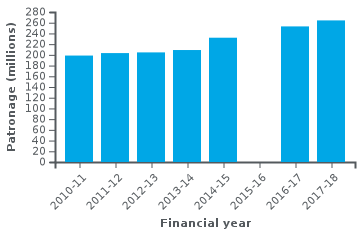 | ||||||||
| Region 1 | 12 662 000 |
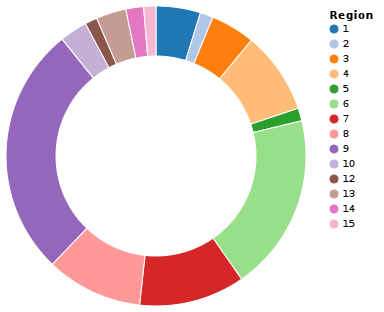 |
| Region 2 | 3 710 000 | |
| Region 3 | 12 637 000 | |
| Region 4 | 23 441 000 | |
| Region 5 | 3 650 000 | |
| Region 6 | 50 509 000 | |
| Region 7 | 30 176 000 | |
| Region 8 | 27 496 000 | |
| Region 9 | 71 556 000 | |
| Region 10 | 7 888 000 | |
| Region 12 | 3 491 000 | |
| Region 13 | 8 559 000 | |
| Region 14 | 5 028 000 | |
| Region 15 | 3 504 000 |
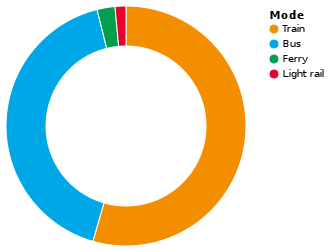 |
Fleet
Bus types
%2C_operated_by_Hillsbus%2C_Bustech_CDi_at_Castle_Hill_Interchange.jpg)
As the Government has moved to a contestable contract model since the Unsworth report, so it has acquired a greater interest in the buses acquired to operate its routes. The NSW Government buys many of the new buses entering service in private operator fleets, and enjoys step-in rights where a private operator loses a contract. State Transit and the private operators must buy new vehicles from approved panel suppliers. These are Asia Motors, Bustech, Custom Coaches, Heavy Vehicles Australia, Hino, Iveco, MAN, Scania, Volgren and Volvo.
The approved bus types are:[18]
- 14.5-metre two-door city bus, with a combined seating and standing capacity of 80
- 18-metre articulated two- or three-door city bus, with a combined seating and standing capacity of 110
- 12-metre two-door double deck city bus, with a combined seating and standing capacity of 90
- 10-metre single-door 'mini' bus, with a combined seating and standing capacity of 40
- 12.5-metre single-door city bus, with a combined seating and standing capacity of 65
- 12.5-metre single-door school bus, with a combined seating and standing capacity of 70
- 12.5-metre two-door school bus, with a combined seating and standing capacity of 65.
In 2017 the government announced that articulated buses would be progressively phased out in favour of double-deckers.[19]
Livery
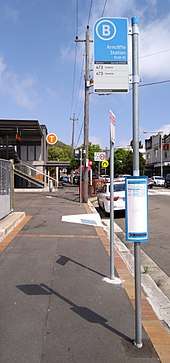
Until 2010, each bus operator determined the livery for their vehicles. In late 2010, the NSW Government introduced a new livery for use on all new vehicles entering service on the network. The design is composed of a light blue (Pantone Matching System 297) background, a white chevron shape pointing in the direction of travel, and dark blue (Pantone Matching System 281) bumpers. Although there was some resistance from bus operators, including Forest Coach Lines, who feared losing their brand identity, all operators had accepted the new requirements by 2013.[20][21][22]
Bus priority infrastructure
Many roads in Sydney have bus priority lanes. There are two types of bus lanes in Sydney;[23]
- Bus Lane - For use by Taxis, Hire Cars (Not Rentals), Motorcycles, Bicycles, Emergency Vehicles and special purpose vehicles and vehicles also operated by or under the direction of Roads and Maritime Services.
- Bus Only Lane - For the exclusive use of Buses and authorised special purpose vehicles.
Many of them are operational for 24 hours, or during the peak hour. Cameras are often set up along bus lanes and drivers who break rules by driving along bus lanes at dedicated times are fined.[24]
Dedicated bus only roads include a separate road in Moore Park which shadows parts of Alison Road and Anzac Parade,[25] the Bennelong Bridge, as well as dedicated roadways at the centre of M2 Hills Motorway[26] and T-ways.
Sydney has two operating transitways (or T-ways):
- The Liverpool–Parramatta T-way opened in 2003
- The North-West T-way opened in 2007
These T-ways can only be used by buses or authorised vehicles. Cameras have been set up along the T-way and vehicles without unauthorised access are fined.
Ticketing and fares
The bus network uses the smartcard-based Opal ticketing system. Opal is also valid on light rail, train and ferry services but separate fares apply for these modes. Opal's bus fares are the same as those for light rail but the fares are not combined when interchanging between the two modes. This is due to change once the CBD and South East Light Rail opens; all bus passengers interchanging with light rail will only pay one fare, calculated from the start of their trip on one mode to the end of their trip on the other.[27][28] Bus drivers also sell non-smartcard Opal single trip tickets. The single trip tickets are more expensive than the standard Opal fare. They are only valid for travel on the bus service on which they are purchased.[29] The following table lists Opal fares for reusable smartcards and single trip tickets as of 2 July 2018:[30]
| Bus or light rail | 0–3 km | 3–8 km | 8 km+ |
|---|---|---|---|
| Adult cards | $2.20 | $3.66 | $4.71 |
| Other cards | $1.10 | $1.83 | $2.30 |
| Adult single trip | $2.80 | $4.40 | $5.80 |
| Child/Youth single trip | $1.40 | $2.20 | $2.90 |
Notes and references
- 1 2 3 4 Lee, Robert (2010). Transport: an Australian history. Sydney: UNSW Press.
- ↑ JMacR. "Manly's first bus". Manly Library Local Studies Blog. Retrieved 6 March 2016.
- ↑ Simpson, Margaret (2006). "New South Wales Government and private bus ticket collection" (published 1960). Retrieved 6 March 2016.
- ↑ State Records Authority of New South Wales. "Department of Road Transport & Tramways".
- ↑ State Records Authority of New South Wales. "Department of Government Tram and Omnibus Services (1952) / Department of Government Transport (1952-1972)".
- ↑ Department of Environment & Planning (1988). Sydney Into Its Third Century: Metropolitan Strategy for the Sydney Region. Sydney.
- ↑ Ashton, Paul; Freestone, Robert (2008). "Planning". Dictionary of Sydney. Dictionary of Sydney Trust.
- ↑ Annual Report for year ended 30 June 2014 Transport for NSW pages 38-39
- ↑ New B-Line to transform Northern Beaches Bus travel Transport for NSW 9 November 2015
- ↑ Transit Systems secures Region 6 Bus Contract (Final Paragraph} Transit Systems
- 1 2 "On Demand public transport". Transport for NSW. Retrieved 6 August 2018.
- ↑ "Wetherill Park On Demand service". Transport for NSW. Archived from the original on 7 August 2018. Retrieved 7 August 2018.
- ↑ "Transport for NSW Annual Report 2013-14" (PDF). Transport for NSW. p. 395. Retrieved 1 August 2016.
- ↑ "Transport for NSW Annual Report 2014-15" (PDF). Transport for NSW. p. 131. Retrieved 1 August 2016.
- ↑ "Bus Patronage - Monthly Figures". Transport for NSW. Retrieved 13 September 2018.
- ↑ "Bus Patronage - Monthly Figures". Transport for NSW. Retrieved 14 September 2018.
- ↑ See Transport for NSW patronage in Sydney by mode for sources
- ↑ Transport for NSW (June 2010). "Outer and metropolitan bus system bus specification guidelines".
- ↑ Gerathy, Sarah; Raper, Ashleigh (13 June 2017). "NSW Budget: New hospital, bus boost and roads planning announced with one week to go". ABC News. Australian Broadcasting Corporation. Retrieved 20 June 2017.
- ↑ Smith, Alexandra (22 December 2010). "Out of the blue, an illusion of more buses, all dressed alike". Sydney Morning Herald.
- ↑ Blue over green Forest Coach Lines buses Archived 2013-04-29 at the Wayback Machine. Manly Daily 11 January 2013
- ↑ Transport for NSW (October 2013). "Livery specification, Custom Coaches rigid 12 metre" (PDF).
- ↑ NSW, Roads and Maritime Services,. "Bus lanes". Roads and Maritime Services. Retrieved 2016-05-02.
- ↑ "Bus lanes". rms.nsw.gov.au. Retrieved 15 October 2015.
- ↑ "Temporary closure of Moore Park Bus Roadway from 5 June - 26 Feb 2015". State Transit. Archived from the original on 2 July 2015. Retrieved 2 July 2015.
- ↑ Tan, Su-Lin (12 March 2015). "Traffic chaos as bus catches on fire on M2 motorway". The Sydney Morning Herald. Retrieved 2 July 2015.
- ↑ "Opal to go live on light rail months ahead of schedule". Transport for NSW. 24 November 2014.
- ↑ Opal rollout extends to light rail Archived 6 October 2014 at the Wayback Machine. Transport Info NSW 25 November 2014
- ↑ "Opal single trip tickets". opal.com.au. Transport for NSW. Archived from the original on 11 June 2016. Retrieved 4 July 2016.
- ↑ "Opal fares". opal.com.au. Transport for NSW. Retrieved 2 July 2018.